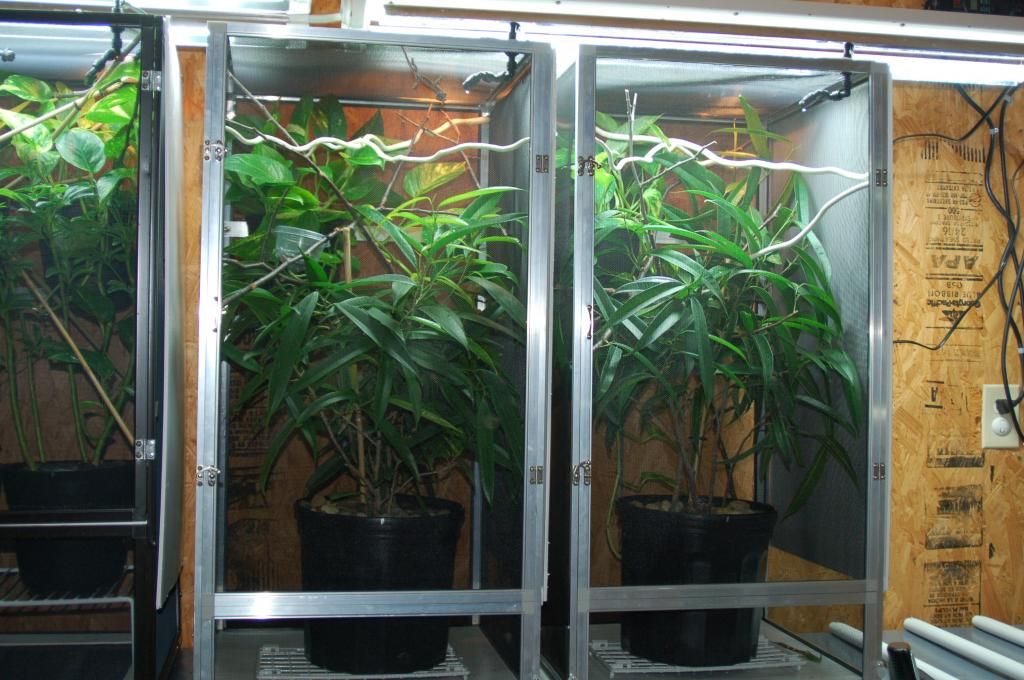Saldarya
Established Member
Evening All,
I am starting this thread as a means to share details of keeping these animals in the hope that any that are involved can point out issues and opportunities that they see as well as track their progress.
Call it a log of sorts and I will try and update weekly.
I will start with the basic Set ups:
Cage Size: 36"x18" screen cages.
Planted with live plants as can see in the pictures.
Lighting: 6% Arcadia T5 with reflector, 6500K T5 Plant bulb
Watering: Mist King set up to mist 2X a day. 45 seconds 30 minutes after lights come on and then 30 sec 6 hours later allowing then 6 more hours to completely dry out prior to lights out.
Temps. Ambient Room temp is 73 during the day and drops to 62ish at night. RH in the room itself ranges from 68-88% depending on time of day and various misting. That is the RH outside as well BTW. The humidity in the cages is less due to temps in the cage. Basking Spot is 81-82 deg with a gradient in the cage from there down to room temp of 73 at the bottom of cage.
Air Flow: There is a 9" fan at floor level that runs on low pointed up and behind the cages. This provides some air flow that ensures cages dry out quickly. There does not appear or feel like there is any draft in the cage itself. The Room AC brings in and recycles fresh air as well as other fans in the room that move air around for even room temps.
The animals themselves came from Paul who has had them for while and are stable and by all accounts are healthy and in good shape. I am hoping that because they have been in captivity for a while and not recent imports that this will provide an edge.
Feeding: I have FF, various sizes of crickets, flour beetles, small P Worms, sm RR and dubia roaches. Also have silks hatching atm. They appear to be eating FF and the 1/8 crix pretty well and I will continue to offer new foods to them. Thus far they are only interested in hunting free range, but I have added small feeding cups in the enclosures in the hope that they will learn to eat from them so I can track their feeding progress.
Please ask questions of anything I may have missed or that you have questions about. I will get pics of the actual animals later this week.
Here are some pics of the set ups.


I am starting this thread as a means to share details of keeping these animals in the hope that any that are involved can point out issues and opportunities that they see as well as track their progress.
Call it a log of sorts and I will try and update weekly.
I will start with the basic Set ups:
Cage Size: 36"x18" screen cages.
Planted with live plants as can see in the pictures.
Lighting: 6% Arcadia T5 with reflector, 6500K T5 Plant bulb
Watering: Mist King set up to mist 2X a day. 45 seconds 30 minutes after lights come on and then 30 sec 6 hours later allowing then 6 more hours to completely dry out prior to lights out.
Temps. Ambient Room temp is 73 during the day and drops to 62ish at night. RH in the room itself ranges from 68-88% depending on time of day and various misting. That is the RH outside as well BTW. The humidity in the cages is less due to temps in the cage. Basking Spot is 81-82 deg with a gradient in the cage from there down to room temp of 73 at the bottom of cage.
Air Flow: There is a 9" fan at floor level that runs on low pointed up and behind the cages. This provides some air flow that ensures cages dry out quickly. There does not appear or feel like there is any draft in the cage itself. The Room AC brings in and recycles fresh air as well as other fans in the room that move air around for even room temps.
The animals themselves came from Paul who has had them for while and are stable and by all accounts are healthy and in good shape. I am hoping that because they have been in captivity for a while and not recent imports that this will provide an edge.
Feeding: I have FF, various sizes of crickets, flour beetles, small P Worms, sm RR and dubia roaches. Also have silks hatching atm. They appear to be eating FF and the 1/8 crix pretty well and I will continue to offer new foods to them. Thus far they are only interested in hunting free range, but I have added small feeding cups in the enclosures in the hope that they will learn to eat from them so I can track their feeding progress.
Please ask questions of anything I may have missed or that you have questions about. I will get pics of the actual animals later this week.
Here are some pics of the set ups.




